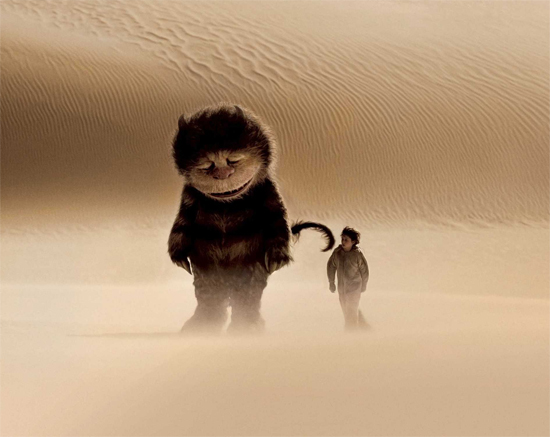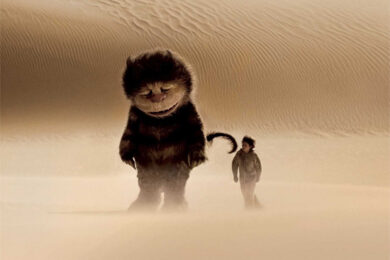Where the Wild Things Are, the new adaptation by Spike Jonze and Dave Eggers of Maurice Sendak’s classic of springtide macabre, is not a kid’s movie in the usual sense. Most fiction ‘for’ children, whether on the page or on the screen, is still told in the voice of an adult telling a story to a child, rather like an episode of Childrens BBC’s Jackanory. ‘Once upon a time… " they begin, or something of the sort, in an establishing sort of way. Sendak’s original picture book similarly, "The night Max wore his wolf suit and made mischief of one kind…" Not so, Jonze’s new film. From its thrilling opening minutes, we are thrown immediately into the world of the boy, Max, experiencing the story through his eyes and from his point of view. There is no establishing wide shot to ground us, and throughout the film our kino-eye is roaming around, almost perpetually low-angle, jerkily handheld. The world of Max, the little boy who dons his wolf suit and drifts away to a far away place to become king of the Wild Things, is a world both disquietingly brute and uncannily familiar.
Unpacking Sendak’s slender volume – a mere forty-odd lines spread over some thirty illustrated pages – into a fully fledged feature (the last ‘film’ of Where the Wild Things Are was a mere seven minutes long) has inevitably necessitated some interpolations, some of which are bound to grate with some of the book’s older fans. If the thought of the beasts cherished since childhood voiced (or rather ‘re-voiced’ – for didn’t they always have voices when we first met them, all those years ago?) by a posse of hip, mostly young, American actors, resembling – almost – the cast of a Richard Linklater film, brings a choke of panic to our expectations, then I should counsel caution before an overhasty dismissal. This may be the first ‘indie’ kids’ movie (it even has Karen O on the soundtrack), but it is never cool except in the service of the characters’ emotional psychology.
Although Jonze is less explicit than Sendak that Max’s adventure on the island is just a dream, it remains instructive to view the tale as a kind of Freudian psychodrama. Max’s escape to the island of the Wild Things is precipitated by a threefold crisis: first, an existential crisis, brought about by his school teacher’s casual announcement that even the earth’s sun will someday die; second, a social crisis, brought about by his failure to interact as equals with the cool kids his sister hangs out with; and finally, an oedipal crisis brought about by the sight of his mother (played by Catherine Keener) kissing another man. Finding his position as ‘man of the house’ (in the home he shares with his single mother and older sister) threatened by the presence of this lusty interloper, he tries first to re-assert his masculine authority by standing on the kitchen table, stamping his foot, and ordering his mother to do his bidding. On the failure of such, he is forced to escape into his own unconscious, wherein he can fully assert his authority over the ‘wild things’ of his own destructive id.
By, then, making himself king of the wild things, Max is able to learn to control the destructive urges we are thrust into the centre of as the film begins. However, unlike in Sendak’s book, it is not the smell of his ‘still hot’ supper that brings Max back home and back to reality. Rather, having first subjugated the beasts on the island (who are as much the phantasmatic representation of his sister’s group of friends, as they are Max’s innermost destructive urges), he is only able to leave once he has been able to relinquish this mastery, and leave the wild things behind, less as either subjects or potential tormentors, than as friends, or rather as brothers and sisters, with whom he stands on an equal footing. Max’s inner crisis is therefore solved by this reverie, which makes up the bulk of the film and pretty well the whole of the book, in which he is able to both create a fantasy world in which, as James Gandolfini’s great monster, Carol, says, "only the things you want to happen will happen," find acceptance amongst this older, ideal social group, and then both establish his patriarchal authority and, magnanimously, relinquish it, accepting the free play of his desires beyond the repression of the super ego.
Spike Jonze thus effects with Sendak’s, already fairly legendary, book, something of what Richard Wagner achieved with the Germanic myths behind the Ring cycle: fleshing out the basic story, using the most advanced contemporary techniques to heighten, as much as possible, the emotional force; and drawing out those aspects which point towards the universal. Though never as poetic as Wall-E, and frequently (though perhaps predictably) mawkishly sentimental, Where the Wild Things Are remains nonetheless a quite singular film: no more a film necessarily ‘for’ kids than The Wild Bunch is a film necessarily ‘for’ cowboys.



